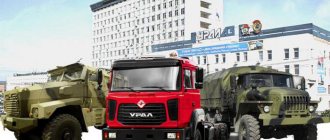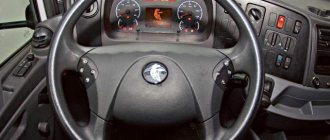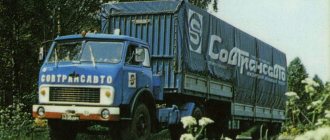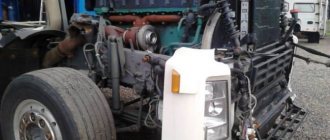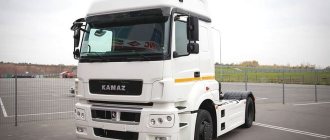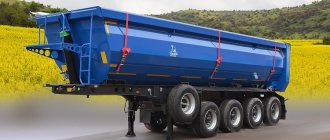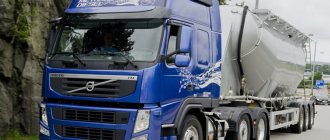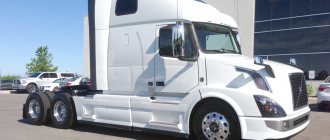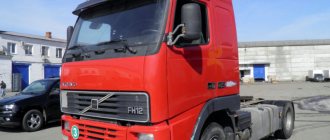Base
Creators
Name
Development
The history of the Volvo brand dates back to 1927. Initially, the concern was a subsidiary of SKF, which produces bearings. The founding of the company was marked by the release of the first car called Jakob OV4 - an open model with a two-cylinder engine producing 28 horsepower. A few years later, Volvo gained independence. Since then, the company has undergone many ups and downs, but today cars of this particular brand are reliable and safe. Volvo deservedly inspires the trust of a large number of car enthusiasts.
Birth of a brand
The founding date of the Volvo company is considered to be April 14, 1927, when the first production cars were assembled under the leadership of Assar Gabrielson and Gustav Larson.
But the history of the companies from which the Volvo Construction Equipment division, which produces construction equipment, emerged began much earlier. Volvo AB was founded in the mid-1920s as a subsidiary of the famous Swedish bearing manufacturer SKF. The first Volvo passenger car left the factory on April 14, 1927. This date is considered the founding day of Volvo. In 1929, SKF almost sold Volvo to the Americans as it was unprofitable. Volvo finally separated from SKF in 1935. Before World War II, Volvo produced cars, trucks, and buses. With the outbreak of the war, the company began producing military equipment.
Are there other countries in the world where Volvos are assembled?
Many car enthusiasts confuse Sweden with other Scandinavian and European countries, believing that Volvos are assembled in Norway, Switzerland or even Germany. In fact, Volvo Corporation's only plant is located in Gothenburg, Sweden. This enterprise, even after the purchase of the concern by the Chinese, remains in this city and does not reduce its activities.
On the contrary, Chinese investment has given the Swedish company a huge boost. There are several important aspects that changed in 2007:
- money and technical capabilities appeared to develop a completely new model range;
- the efforts of the designers of the already powerful company Geely and the Swedes combined;
- the Volvo brand has received a huge Chinese market, where its cars are sold without unnecessary duties;
- new technologies began to be introduced into cars, thanks to generous investments;
- the plant expanded its staff, improved production lines and received many other benefits.
If we consider the technology of car manufacturers today, we can safely say that Volvo is one of the best factories in Europe. The latest equipment is installed here; all assembly processes are fully automated. The cars are not just of high quality, they finally live up to their price tag. Until 2007, Volvo cars were bought only in Scandinavian countries. They were too expensive and outdated.
Start of production of special equipment
During the war, the Swedish government banned the production of civilian passenger cars. Volvo management to utilize idle capacity in 1943–1944. decided to manufacture agricultural tractors.
In order to strengthen the new production sector, in May 1950 Volvo decided to acquire AB Bolinder-Munktell, a company specializing in the production of engines, road construction equipment and tractors. By the time of the merger with Volvo, the history of Bolinder and Munktell had already been decades old, they had international fame, authority and a high image in the market. The acquisition of VM was a turning point in the history of the development of Volvo's special equipment sector: the company increased the volume and production line of agricultural, construction and forestry equipment.
Bolinder-Munktell ancestor of Volvo
Swedish engineer Johan Theofron Munktell worked as a foreman at the Royal Mint in his youth.
In 1832, Munktell, at the age of 27, left his post and moved to Eskilstuna, where he founded the mechanical workshop Munktells Mekaniska Verkstads Aktiebolag. The year 1832 is considered to be the founding date of the oldest company, from which Volvo Construction Equipment later descended. In 1835, Munktell traveled to England, where he became acquainted with the production of steam locomotives. In 1853, Munktells Mekaniska Verkstad introduced the first Swedish locomotive. In addition to the steam locomotive, Munktell invented the first Swedish loom, the first Swedish combine harvester, a sliding dome for the Uppsala University Observatory, as well as heating systems for prisons. After the death of the founder in 1906, the company's first construction machine, a steam roller, was born, and in 1913, the first Swedish agricultural tractor.Munktell's place as master of the Royal Mint in 1832 was taken by the young, gifted engineer Jean Bolinder. In 1842, together with his brother Karl Gerhard, he went to England to study. Upon returning to Sweden in 1844, they founded the company Bolinders Mekaniska Verkstad. In 1883, Bolinders became world famous: the brothers took part in the construction of the world's first armed submarine. One boat was sold to Greece, the second to Turkey. In 1893, the Bolinders created the first Swedish internal combustion engine - a single-cylinder, four-stroke engine running on kerosene.
In 1929, a global economic crisis broke out. To survive, Bolinder and Munktell decided to merge: in 1932, the united company AB Bolinder-Munktell was created. Thus, the year 1932 became an important milestone in the history of Volvo Construction Equipment.
In May 1950, Volvo acquired Bolinder-Munktell.
In 1954, the first Volvo H10 front wheel loader was created on the basis of a Volvo agricultural tractor, only the operator’s seat was rotated 180°, that is, he sat with his back to the engine. In 1964, the first serial backhoe loader Volvo GM611 based on a tractor was released. The bucket capacity was 0.4 cubic meters. In 1966, serial production of the world's first articulated dump truck, the DR631, began, the development of which began nine years earlier. The machine is based on an agricultural tractor with a one- or two-axle dump trailer connected by an articulated joint. A modification of the SM667 articulated machine was created for the logging industry. Thanks to control by folding the half-frames at the joint, the machine had high maneuverability.
In 1969, the Swedish company ASJ was acquired, whose front wheel loaders ideally complemented the Volvo loader line. ASJ loaders were not based on agricultural tractors, like Volvo, these machines were created specifically as loaders. Most ASJ loader models had an articulated frame.
Production of construction equipment
In 1977, Volvo underwent a major reorganization: production of agricultural and forestry equipment ceased and the main resources were concentrated on the production of the most profitable construction machines: wheeled front loaders, articulated dump trucks and earthmoving equipment.
As part of the program to gain a leading position in the global construction equipment market, the joint venture VME (Volvo Mitchigan Euclid - the three most significant brands that made up this enterprise) was formed in 1985. In 1990–1991 VME acquired two companies, which allowed it to enter sectors of the construction equipment market in which it was not previously present. A°kerman was one of the largest Swedish manufacturers of heavy earthmoving machines. With its addition, VME now has a full line of crawler and wheeled excavators. Zettelmeyer is a well-known German manufacturer of wheeled front loaders. The addition of this company allowed VME to penetrate the German front loader market.
Emblem
In order for the models of a new automobile manufacturer to be recognized all over the world (and this was an integral point in the brand development strategy), a logo was needed that would reflect the company’s peculiarity. The Latin word Volvo was taken as the name of the brand. His translation (I roll) perfectly highlighted the main area in which the parent company excelled - ball bearings.
Leiba appeared in 1927. The symbol of iron, which was common in the culture of Western peoples, was chosen as a distinctive design. It was depicted as a circle with an arrow directed to its northeastern part. There is no need to explain at length why this particular decision was made, because Sweden has a developed steel industry, and its products were exported almost throughout the world.
Initially, it was decided to install the badge in the center of the main air intake. The only problem that the designers encountered was the lack of a radiator grille on which the emblem could be attached. The logo somehow needed to be fixed in the center of the radiator. And the only way out of the situation was to use an additional element (it's called a bar). It was a diagonal strip to which the badge was attached, and it itself was fixed to the edges of the radiator.
Although modern cars have a protective grille by default, the manufacturer decided to leave the diagonal stripe as one of the key components of the already famous car logo.
Volvo Construction Equipment
The year 1995 is very important in the history of the Volvo construction equipment division. It was in that year that the VME joint venture became fully owned by the Volvo Group. Due to the change in ownership, VME was renamed Volvo Construction Equipment Corporation (VCE). All companies that were part of VCE and were newly acquired were now named Volvo, including the Samsung excavator production in South Korea now becoming Volvo Excavators. In total, VCE produced more than 20,000 units in 1995. products 130 models.
In 1997, VCE acquired Champion Road Machinery, Ltd., a Canadian manufacturer of motor graders, road rollers and pavers. By 2002, VCE had grown into the world's largest line of premium construction equipment: articulated dump trucks, front wheel loaders, mini and full-size excavators, motor graders, and more.
In 2007, Volvo acquired a 70% stake in Chinese wheel loader manufacturer Shandong Lingong (SDLG). The company has invested heavily in upgrading technology at SDLG factories and is helping to promote SDLG products in the global market. Cars under the Volvo and SDLG brands occupy different price niches on the world market, strengthening each other’s positions.
The development of the Volvo CE product line continues today. In 2011–2012 F-series articulated dump trucks, G-series wheel loaders, B-series backhoe loaders, B-series asphalt pavers, updated models of skid steer loaders, D-series crawler excavators, and a new model of the EW145B Prime wheeled excavator appeared.
Russian Volvo plant
Russia has become another market into which the company has introduced its capabilities. Today in Kaluga the production of the following trucks has been launched:
Suppliers of components to the plant are Sweden, Belgium and Germany, France and India. The Volvo Trucks concern, whose policy is aimed at selling products in the countries where they are produced, provides the Russian market with reliable freight transport.
The Russian manufacturer plans to produce up to 7 thousand trucks per year. Despite the consequences of the crisis, well-established truck manufacturing activities have been maintained in Kaluga and continue to provide employment for thousands of workers.
The company makes big bets on heavy engineering and special transport. The Kaluga plant is the most modern and modernized of all units in the Volvo Trucks line.
In 2002, at the Detroit Auto Show, the Swedish auto company Volvo presented its new creation - the Volvo XC90 mid-size crossover. The car was built on the P2 platform. After the presentation of the car, its popularity increased greatly. Russian motorists really liked this crossover. But, before purchasing a car, buyers are interested in where the Volvo XC90 is assembled for the domestic market? For some time, this car model was assembled at a Swedish plant located in the city of Gothenburg. But, after the crisis “covered” Europe, the production of the crossover was moved to China, to the city of Chengdu. The company was opened here back in 2010 and assembles cars to this day. It turns out that on the Russian market you can buy a Chinese-assembled car.
The car underwent its first restyling in 2006. Our compatriots can purchase a Swedish crossover with a gasoline or diesel engine. The car turned out to be elegant, modern and practical. It seems to have been created specifically for use on our roads, since it has excellent cross-country ability. But is this car good in everything else, let's figure it out.
Milestones in the history of Volvo Construction Equipment
| 1832 |
|
| 1853 |
|
| 1880 |
|
| 1893 |
|
| 1897 |
|
| 1906 |
|
| 1913 |
|
| 1914 |
|
| 1924 |
|
| 1932 |
|
| 1936 |
|
| 1939 |
|
| 1940 |
|
| 1950 |
|
| 1952 |
|
| 1954 |
|
| 1955 |
|
| 1966 |
|
| 1967 |
|
| 1969 |
|
| 1972 |
|
| 1973 |
|
| 1977 |
|
| 1984 |
|
| 1988 |
|
| 1991 |
|
| 1995 |
|
| 1999 |
|
| 2001 |
|
| 2002 |
|
| 2003 |
|
| 2006 |
|
| 2007 |
|
Features of the “Swede”
The manufacturer has thought through the interior of the crossover to the smallest detail. There is plenty of space here, passengers will feel comfortable and comfortable.
The dashboard includes:
- multimedia system
- gsm phone
- auxiliary function control system
- climate control system.
The steering wheel also has additional buttons with which the driver can control and configure the vehicle's systems. Where they produce the Volvo XC90 for Russia, they try to adapt the car as much as possible to our roads. For rear seat passengers, the manufacturer installed audio system control units on the rear pillars. The second row of seats can comfortably accommodate three adults. Each car seat is adjustable and has a folding backrest.
The third row consists of full-size seats; they can be folded together, thereby increasing the volume of the luggage compartment several times. The crossover dimensions are: 4800 mm × 1890 mm × 1740 mm. Maximum speed is 210 kilometers per hour. To accelerate the car to the first hundred with “mechanics” it will take 9.9 seconds. with automatic transmission - 10.3 seconds. It is difficult to call a crossover economical in terms of fuel consumption. In the city, the SUV consumes 16.1 liters of gasoline.
Line of produced equipment
Volvo Construction Equipment offers its customers a wide range of products, many of which are recognized as the most productive and efficient in their class.
- Articulated dump trucks are a cutting-edge development from Volvo. Designed to transport large volumes of material over difficult terrain.
- Excavators (tracked, wheeled, compact);
- Wheel loaders;
- Backhoe loaders;
- Skid Steer Loaders;
- Pipelayers;
- Asphalt pavers (tracked, wheeled);
- Rollers (asphalt, soil);
- Self-propelled graders;
- Tracked harvesters.
Chinese Geely cars after cooperation with the Swedes
Immediately after the merger of European and Chinese manufacturers under the roof of one concern, Geely had new models that were three heads higher than their predecessors. In fact, the entire model range has changed, new engines began to produce more horses, requiring less fuel. And the appearance of the Emgrand series has greatly advanced.
We invite you to enjoy the video test drive of the new Emgrand EC7
Video:
A crossover, which had not been announced before, even appeared in the Geely model line. Such changes are associated with the following development options for the company:
- despite the ban on the use of Volvo technologies, the Chinese pulled certain developments of the Swedes to their side;
- as a result of bilateral cooperation with European engineers, new developments were obtained;
- the company received a good income-generating asset and was able to invest in its own production;
- Engineers from Sweden were invited to work in China.
The last assumption is a tested and proven fact. But Geely denies the fact that this is related to the development of the successful Engrand series of cars. However, for the consumer there is no difference. If a company produces good cars, let it take technology where it is more convenient for it. What is more important for the consumer is how high-quality a car he can purchase at the dealership. That is why the Swedes today are quite happy with their seven-year cooperation with the Chinese.
The plant in Gothenburg is growing and developing, the brand is acquiring new models, and the Geely corporation is fulfilling all its main promises.
In Russia
The company has been present in Russia since 1998, when it was created.
On April 18, 2012, Volvo CE underlined its commitment to the Russian market by laying the foundation stone for an excavator plant in Kaluga. The new plant will be Volvo's seventh excavator facility and will produce six models of the EC range of crawler excavators.
On May 14, 2013, Volvo Construction Equipment celebrated the opening of its excavator plant. More than 500 people took part in the official ceremony in Kaluga.
The site of the company:
Alternative names:
VOLVO | Volvo Group | Volvo CE | Volvo Construction Equipment | Volvo
The Sklad.ru company offers a wide range of spare parts for Volvo road construction equipment.
Technical side
The first generation Volvo XC90 was equipped with four powertrain options:
- basic 2.5-liter petrol (210 hp)
- diesel 2.4-liter (163 and 184 hp)
- petrol 4.4-liter (325 hp).
The second generation crossovers were equipped with engines that had undergone some changes. One of the two gasoline engines has become much more economical in terms of gasoline consumption. And the diesel engine began to produce two hundred horsepower. Where the Volvo XC90 is produced, they know how important it is to make the car accessible to more people.
Therefore, each successive restyling had a positive effect on the crossover itself. After the next update, which took place in 2013, the manufacturer reduced the number of engines to two. There are 2.5-liter gasoline and 2.4 diesel engines left. Today on the Russian market, buyers can purchase a crossover in three trim levels and with two engines to choose from. The cost of the basic version of the car varies from 1,800,000 to 1,976,000 rubles. Even the simplest crossover has a good “filling”:
- parking sensor
- climate control
- anti-theft system
- heated exterior mirrors
- immobilizer
- Cruise control
- external car lighting
- audio system
- seventeen-inch wheels.
Prices for cars in the “Executive” configuration range from 1,999,000 to 2,196,000 rubles. There is also a Volvo XC90 “R-Design” crossover, its cost ranges from 1,899,000 to 2,096,000 rubles.

